I, Maeve Alpin, stand on the dock of the airship, clutching my purple hat, as my hair streams in the blustering wind. Thrilled to meet Steampunk author, Heather McDougal and discover more about the intriguing contest she devised to celebrate the release of her new Steampunk novel, Songs For A Machine Age.
Her contests entrants created works of art depicting the Steam Beast, a mechanical character from Songs For A Machine Age. She opened the contest to various mediums, whatever the entrants were best at: sculptures, computer created, hand drawn, painted or mix-media. The artist sent in high-quality digital images one for 2-D work and 3 for 3-D work. The deadline fell on October 28, 2012.
“Welcome, Heather.” I shove my hat on my head and take her arm in mine. “Watch your step.” We stretch our legs in a long stride across the wide gap between the dock and the airship, to board. I lead her into the parlor.
Heather McDoural gracefully lowers herself onto the crimson settee, featuring elaborately carved lion head legs and claw feet.
I sink into the chenille upholstered armchair and lean forward. “I am fascinated by an art based contest. How did you come up with that idea?”
“Well, I come from an art background with an MFA in sculpture. Writing was something I wanted to do as a young person, I got distracted by other skills for a long time. I earned a degree in fashion design and worked in the garment industry for several years, and then went back to school to study textiles. Once you’re in the art department, it’s pretty hard not to try all kinds of things, so I ended up learning to blow glass and weld and so on, and finally ended up with this sculpture degree. However, my thesis won me extreme praise where my sculpture had only been reasonably good, and this made me revisit writing.
Also, this book is all about a culture of makers. Three hundred years before the narrative, they were in the middle of an industrial revolution and someone invented a truly horrific manufacturing technology. I won’t tell you more about it, except that it was the catalyst for a revolution in which all machinery was banned, with the exception of handmade devices with purely aesthetic value. So as a result, skill in making things has become a highly-prized commodity.
It seemed appropriate, then, to bring art-making into the promotion of Songs.”

The engine purrs and the blue willow teacups shake on the coffee table causing a clinking, rattling sound as the airship lifts off. “With your varied but strong artistic background, I can see why you were inspired to write a book with this wonderful premise of ‘all machinery was banned, with the exception of handmade devices with purely aesthetic value.’ Speaking of machinery, the subject of the contest is the Steam Beast, a mysterious, mechanical character. Tell us a little bit about him.”
“He was created by Pelle Vidersen, a woman who lived around the time of the Revolution, who had the unusual skill of being able to create Devices that have sentience, have life. This is a dangerous skill and she wasn’t supposed to use it, or even have the skill – and there were grave consequences. But that’s all in the prequel, which I’m halfway through writing. Suffice to say, you see a great deal more of him there, and get to know him pretty well. In Songs For A Machine Age, he is seen as much less of a person, more of a strange Device that no one could possibly recreate.” Heather grabs the settee with one hand as the airship rises.
“I can’t wait to read about him in the book.” Since the china cups ceased rattling, I picked up the tea pot and poured my guest and myself a cup of Earl Grey. Wisps of steam rose up rom the blue willow cups.“How did you come up with the Steam Beast? Did something particular inspire you to create him?”
“Interestingly, I came up with the name first! The world of songs first appeared in a project I started called Neddeth’s Bed, an experiment in blog storytelling. In it, the protagonist goes to sleep most nights and dreams she is in the body of someone else, someone who is writing on a machine. So she tells her story to that person, who writes it down (as a blog). It’s an exercise in world-building and in dual storytelling — you begin to understand the person she is occupying as the tale unfolds.
This is where the Steam Beast first shows up, as a sort of one-off device in the Midsummer Festival. Somehow, he caught my attention, and when I started this book, he wouldn’t go away. I grew more and more interested in him, wondering about his back-story, until I found myself writing the prequel, just to get him out of my system.” Heather reaches her slender fingers between the plate of fresh lemon slices and the cream pitcher. She picks up a white cube from the sugar bowl and plunks it into her tea.
“It’s interesting that once these characters latch onto our minds,they won’t leave us until we write their stories.” I hooked my fingers in the handle of my teacup and lifted it off the delicate saucer. “You sent the contest entrants a never before seen segment from the prequel to Songs For A Machine Age, in which the Steam Beast is worked on by its creator.Can you share that segment with us? Please! We’d love to read it.”

Rhea Ewing’s winning Steam Beast
“Of course! Here you go.”
“Pinzen,” said Pelle, “It’s time to grow.”
Pinzen came out from its nest among the plants in the corner, moving gracefully. It was definitely ready for more synapses. She squinted at it carefully, thinking that perhaps its carapace needed to be larger, after all. She wasn’t sure how much longer she’d be around to keep wrapping its brain, so this installment might need to be a larger one than usual. It was good she’d planned ahead and had the new carapace already.
She moved across to one of the boxes under the work-counter. Lifting the lid, she inspected the contents carefully. She’d been saving this material for years, since the days when she worked in the automaton factory and smuggled the threads out, piece by piece, in her shirt.
“Hello, Pelle. Did you see my toy? I fixed it,” said Pinzen. “I took two toys and made a new one.”
“Hmm?” said Pelle. “Good for you.” She was inspecting the threads in the box, laying them out in careful skeins on a clean part of the counter. It was essential that she keep them absolutely dust-free and straight or they could cause crossed connections, which could lead to insanity. She had built Pinzen with great care, and was proud of how sane it was.
Pinzen moved its claws, impatiently. “Pelle, did you see it?”
There was a long silence while Pelle went on examining the threads carefully, pulling out the occasional one.
“Pelle!”
“What? What is it, Pinzen?” The machine was acting strange, shuffling its limbs. Pelle frowned, distracted by the task ahead of her.
“Did you see my new toy?”
“New toy?” Pelle turned around. “What do you mean?”
“I took apart two of the toys and made a new one. And I’m working on that one over there,” its claw lifted to indicate an intricate sprawl of wheels and cogs on a sheet of paper in the corner behind the door.
The thing he’d made was completely unlike anything she’d seen before. She pulled over a stool and sat down to look at it. The fluted columns gleamed, and there were several keys or levers clustered together on one side. She reached out and pressed one of the keys, and leaned away with an “Ah!” of surprise and pleasure when the steam-letter rose into the dimness of the room and hovered for a moment before wafting away.
“How did you know what shapes to make?” she asked, pressing another key. Another letter came out, and she marveled at their perfection.
“I made them to look like the shapes in that package,” it said, pointing to a book that she had left on the counter. “I noticed they repeated themselves, so I counted how many kinds of shapes there were, and made one of each.”
“It’s lovely,” Pelle said, fascinated. She pressed several keys in a row and a floating nonsense-word hung in the air between her knees. How did he do it?
“Did you use my tools?” she asked, suddenly.
The machine went very still, and there was a silence. “I did use one tool, Pelle,” it said. “I am sorry.”
She shook her head. “It’s all right, Pinzen. I am amazed at what you’ve done. I should have explained to you why you weren’t allowed to touch my tools. You see, they are very old, and if they break I won’t be able to replace them, ever. So I need to be very careful with them, do you understand?”
“I understand, Pelle.”
“You clearly have a talent for making things. If I could get more materials, I would let you make many more wonderful things. However, I am old, and I can only get a few things, very slowly. So you’ll have to keep yourself busy some other way unless I can find things for you to use.”
“May I use the same tool to reconfigure my other toys?”
“It depends. Which tool was it?”
“The long thin one, with the green handle.”
“Yes, you can use that one. If it breaks, I can get others. But now, Pinzen, you’ll need to sleep, so I can help you grow. All right?”
“Yes, Pelle,” it said, and went completely still. After a few moments she put her hand on its carapace and felt it: it was growing slightly cooler. Good.
She got the new carapace from its shelf and took it outside to wash it. The trouble with this new society, she thought to herself, as she rinsed the dust away and dried it with a soft cloth, was the imprecision of everything. It was so hard to make precise machinery when there were mice getting into everything and the water went unfiltered and there were no factories, making parts. Everything had to be done from scratch, including, at times, the actual foundry-work of heating and mixing the metals. You had to be truly dedicated to make anything.
Then she shook her head. It didn’t matter now; they didn’t need the ability to make precise machinery. Those days were gone. Nobody wanted machines anymore, no matter how brilliant. It was only her own silly need to go on making things that got foiled.
Back inside, she wiped Pinzen down carefully, then spread out a clean sheet and laid the machine on it. It was completely cool by now, and she set to work opening its carapace and setting aside the pieces. The connections between the brain and the limbs were kept intact, and in the center of it all the power source remained, obscured by the network of brain all around it. She disconnected the limbs and put in extenders, sealing the connection tightly so it would last as close to forever as she could make it. Slowly, carefully, she began laying the intelligence threads around and around, sheaf after sheaf of them, matching ends, tying and making careful selective clipping; layer by layer, its brain grew bigger like a ball of yarn. As it grew she said the words which bound it all together, made it whole. It was dangerous, doing this. She had not dared to speak over a machine other than Pinzen for many, many years.\
When she had used up the last sheaf of threads, she covered the whole thing with a fine gold filigreed network like a hair-net, snapping its two halves over the ball to hold it all in place.
Then there was a last round of clipping – creating the synapse points – all around the outside, through the holes in the filligree.
Now it was time for the carapace. Would it fit? With tired, shaking old hands she drew the pieces of the new carapace toward her and tried to fit it all together. The limb-connections had moved a bit, and she had an exhausting fiddle trying to get them to come out in the right places; but eventually, worn out, she put in the last few bolts and the new Pinzen lay before her, much larger than before. And hopefully more intelligent, too.
She shook off the fear she may have made a mistake and he would wake up insane. It was too exhausting to contemplate. Shakily, she got up from the stool and went out to get a cup of cha.” Heather picked up a demure spoon from the coffee table and dipping it into her teacup, she swished it side to side, taking care to not touch the sides.
“It must have been amazing to look at all these different depictions of a character you created in your mind? Did they capture what you imagined? Were some extremely different? Tell us a bit about that experience.” I pinched a slice of lemon, picking it up, I breathed in the invigorating citurs fragrance as I squeezed a few droplets into my tea.
“Well, the first thing I found was a lot of the artists who heard about the contest simply sent me a picture of some previously-created artwork on the off chance that they’d win. A sort of “what can I lose?” attitude. I can understand that attitude, because a lot of artists don’t get much money or recognition for what they do; however, it really wasn’t what I wanted.” With a soft clink, Heather set the teaspoon behind her cup on the saucer. “I had to sift through those people, sometimes checking the portfolios on their websites, before I could get too excited. But then, some things would come in and it was clear the person had created it specifically for the contest. That was amazing. And when Rhea’s picture showed up it was very clear, hands down, she would be the winner. I waited until the deadline, of course, but I just didn’t see anything else that so perfectly captured that moment in the book.
Of course now that I’ve gone through the process, I can see things I would have done differently. For example, early on I would have posted the contest information in art departments in universities and art schools all around the San Francisco Bay Area, which is where I live. Art students are always looking for some money. They have time and they have talent, or at least most of them do. It would have been a good way to get a bunch more original entries!
Also, I would have started earlier, researching places to let people know about the contest. I think it would have been useful to get some personal contacts in those communities beforehand. Simply writing to places that seemed appropriate wasn’t enough; there was little response, and I suspect they couldn’t really vouch for the fact that I really would give the winner $200. If I had had the idea earlier, I could have spent some time getting to know them, so they would hear me when the time came.
Still, it felt truly marvelous to be able to give back to the art community. There was such a wide variety of entries, and the feedback was exciting – people who had never really read anything remotely resembling Steampunk or Clockpunk before, or who were trying new techniques. And Rhea was so excited to win, it really made my week! I still feel good, thinking about that.
Best of all, I think I reached an audience that maybe wouldn’t have heard about my book otherwise.”
I lift my teacup and breathe in the subtle, aromatic scent of the steamy tea. “So Rhea Ewing is your winner. Congratulations to her. What medium was the work in?”
“Rhea Ewing created a 2-D piece, my guess would be charcoal and pastel. You can see more of her amazing work on her website.”Heather picked up her dainty cup from the blue willow saucer.
I brought my teacup to my lips and took a sip. “Can we see the winning piece?”
“Yes!” Heather tilted her teacup to her lips and drew in a long sip, then set it on her saucer with a melodic clink. “Here is the winning piece.” 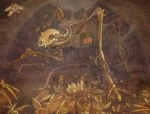
I placed my cup back on its saucer and leaned toward Heather. “I know the winner received $200.00 and a signed copy of Songs For A Machine Age. What a wonderful prize. But you didn’t stop there, you picked three runner ups who received a signed copy of Songs For A Machine Age. Who are your runner ups? Can you describe their art submissions or can we see them?”
“One is a pen-and-ink drawing by Joanne Roberts,

Joanne Roberts’ whimsical drawing
another is a blueprint by Simon Forster,

Simon Forster’s Blueprint
and the last one is a small sculpture by
Ken Bessemer.

Ken Bessemer’s sculpture
I feel lucky to have such a variety!”
As I’m perusing the art of the runner ups, I hear rattling and clinking. I glance at the coffee table. “I see the teacups are shaking. I know what that means, the airship is landing. I have time for just a few more questions. Since this contest is about Songs For A Machine Age, what is the back cover blurb?”
“There is a place where fabulous clockwork devices fill festival streets with color and sound.
Where the Gear Tourniers, in their places of high learning, keep alive the memory of the cruel horrors of an industrial past, now overthrown.
Where skill of the hand and grace of the body are markers of true belief…
Elena Alkeson has been on the run for six years. Wanted by the fanatical Duke of Melifax for witchcraft, nowhere in Devien is safe, as her gift for sensing impending disaster comes with a price: she can’t keep her mouth shut.
…Until she meets Fen, who shares a similar gift: the gift of seeing inside mechanisms and knowing what they do. Elena and Fen must flee for their lives, going to the capital City of Helseve to seek asylum, and, perhaps, a life in which their gifts can be used for good. Amidst the machinery and brilliance of the Autumn Festival, Fen and Elena find friendship, danger, and some powerful allies.
But Melifax and his sect, the dour Browns, are determined to bring the people of Devien into a new age, an age of moralism, conformity and mass production, ensuring that the beauty and pageantry of Devien and its Devices will be lost forever.
I find most blurbs to be a bit over the top by nature, but this one’s not too bad. I’ve also had a friend describe Songs as ‘A capital ‘R’ Romantic Clockpunk adventure, in the spirit of Dumas or the Scarlet Pimpernel, full of personal and political intrigue.’
Publisher’s Weekly said this about it: “Disagreement over technological progress drives social, religious, and political disorder in McDougal’s fantasy debut. Elena Alkeson is on the run from the Duke of Melifax’s followers, the Browns, after her talent for spotting the weak points in structures got her branded a witch. She finds kindred spirits in the Findswather family; the eldest Findswather son, Fen, has the ability to ‘see the workings of a thing.’ Browns support the Duke’s migraine-vision–fueled belief that people should work together in assembly lines to create larger works. Elena, Fen, and others fear this would bring back the awful
‘production-slavery’ of the Ancients as well as the loss of art, independence, and real craftsmanship. While Elena and Fen try to help the Gear-Tourniers and the Curator, a mysterious figure in charge of historic machines, the Browns, plot to bring down the rebels. A large cast of characters and complex world-building fuel the intrigue and action in this intricately plotted fantasy.”
“What a wonderful review.” I flashed Heather a broad smile. “I have to compliment you on the cover. I understand you actually created the cover art yourself.”
“Yes, since graphics is something I do for a living. I asked the publisher if I could submit a cover, and he said ‘Sure, but we might not use it.’ But he liked it so much he did use it, and in fact I’ve done some other covers for him since then.” Heather holds on tight to the arm of the settee, bracing for the shaky landing.
“We’ll we’ve landed but before you go, please share your calling cards with us.”
“Here is the link to my longtime essay blog, filled with all kinds of things Steampunk and otherwise and my website.You can also find me on Facebook.Find the book on Amazon.One might also be able to order the book from one’s local bookstore’s website. I encourage people to try it.”
With the airship Steamed landed, Heather and I exchange goodbyes, but please comment or ask questions below.
~ ~
Maeve Alpin is the author or three Steampunk books, her forth, CONQUISTADORS IN OUTER SPACE, is coming Februay 1, 2013.
Read Full Post »
 Shoptroll: (aka Peter Vanslyke)
Shoptroll: (aka Peter Vanslyke)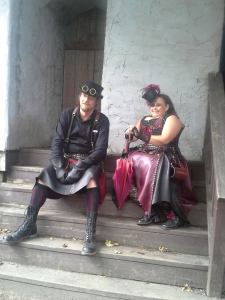 all our Shoptroll finery.)
all our Shoptroll finery.) e or is it a side job?
e or is it a side job? 
 ht want to buy them. I often have to restrain myself from exuberant creativity and focus on making everyday stuff with a just a hint of mad science in them.
ht want to buy them. I often have to restrain myself from exuberant creativity and focus on making everyday stuff with a just a hint of mad science in them. about being a steampunk vendor?
about being a steampunk vendor? 





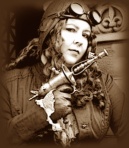



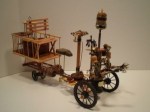
















 Dawn grasps hold of the arm of the settee, bracing for the shaky landing. “Along my travels, some of the vending I did was in Victorian reenactment. I am well versed in the clothing aspect. Steampunk was a natural progression for me. What intrigues me is the inventions, the people who create them and the stories they tell. The community, the ingenuity and historical knowledge of the artists is just delightful.
Dawn grasps hold of the arm of the settee, bracing for the shaky landing. “Along my travels, some of the vending I did was in Victorian reenactment. I am well versed in the clothing aspect. Steampunk was a natural progression for me. What intrigues me is the inventions, the people who create them and the stories they tell. The community, the ingenuity and historical knowledge of the artists is just delightful.






















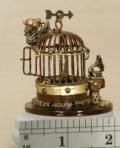

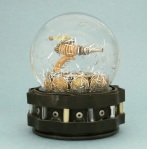












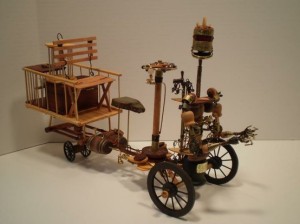






 On my last shore leave I shared my booty of Steampunk comics with you and as promised here are some more. Imagery can be very inspirational to a writer, so many of us pull ideas from our dreams or things that catch our eye. The collaboration of visual and literate art in comics inspires new ideas far beyond the illustrations and story lines. In addition to several comic books labeled as Steampunk, many others have Victorian, Dystopian, Dieselpunk, Weird West, or Alternate History ascetics. Here is part two of my list of some comic books you’ll enjoy.
On my last shore leave I shared my booty of Steampunk comics with you and as promised here are some more. Imagery can be very inspirational to a writer, so many of us pull ideas from our dreams or things that catch our eye. The collaboration of visual and literate art in comics inspires new ideas far beyond the illustrations and story lines. In addition to several comic books labeled as Steampunk, many others have Victorian, Dystopian, Dieselpunk, Weird West, or Alternate History ascetics. Here is part two of my list of some comic books you’ll enjoy. 1. Steampunk by Chris Bachalo & Joe Kelly
1. Steampunk by Chris Bachalo & Joe Kelly 2. Girl Genius by Phil & Kaja Foglio
2. Girl Genius by Phil & Kaja Foglio 3. Gotham by Gas Light by Brian Augustyn & Mike Mignola
3. Gotham by Gas Light by Brian Augustyn & Mike Mignola 4. Hellboy by Mike Mignola
4. Hellboy by Mike Mignola 5. The League of Extraordinary Gentlemen vol 1 & vol 2 by Alan Moore, Kevin O’Neil Illustrator
5. The League of Extraordinary Gentlemen vol 1 & vol 2 by Alan Moore, Kevin O’Neil Illustrator 6. Jonah Hex – Jimmy Palmiotfi & Justin Gray, Luke Ross Illustrator
6. Jonah Hex – Jimmy Palmiotfi & Justin Gray, Luke Ross Illustrator 7. Sherlock Holmes and the Adventure of the Cardboard Box by Sir Arthur Conan Doyle – Retold by Murray Shaw and M. J. Cosson, Sophie Rohrback and J. T. Morrow, Illustrators
7. Sherlock Holmes and the Adventure of the Cardboard Box by Sir Arthur Conan Doyle – Retold by Murray Shaw and M. J. Cosson, Sophie Rohrback and J. T. Morrow, Illustrators  1. Grandville by Bryan Talbot
1. Grandville by Bryan Talbot 2. Lady Mechanika by Joe Benitez
2. Lady Mechanika by Joe Benitez  3. Ruse by Mark Waid (2nd half of the series written by Scott Beatty)
3. Ruse by Mark Waid (2nd half of the series written by Scott Beatty) 4. Scarlet Traces by Ian Edginton, Art by D’Israeli
4. Scarlet Traces by Ian Edginton, Art by D’Israeli 5. The Clockwork Girl by Sean O’Reilly and Kevin Hanna
5. The Clockwork Girl by Sean O’Reilly and Kevin Hanna 6. Ignition City by Warren Ellis, Art by Gianluca Pagliarani
6. Ignition City by Warren Ellis, Art by Gianluca Pagliarani 7. Iron West by Doug Te Napel
7. Iron West by Doug Te Napel 







